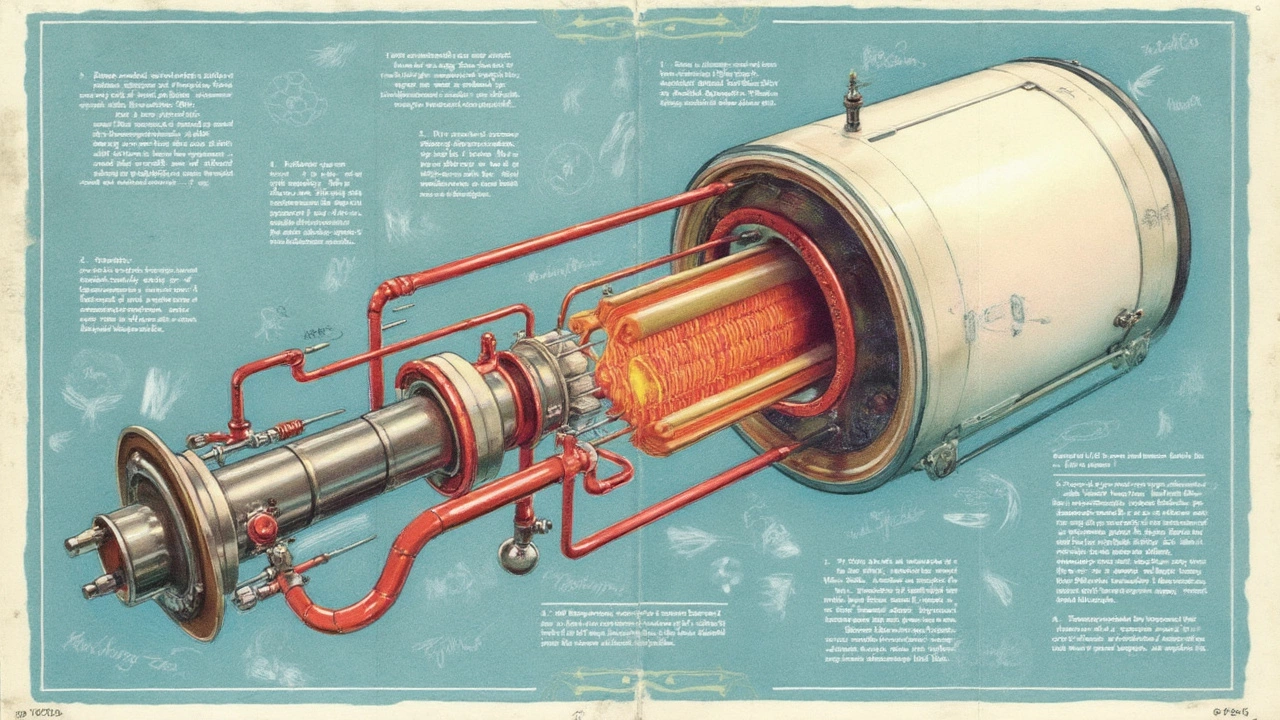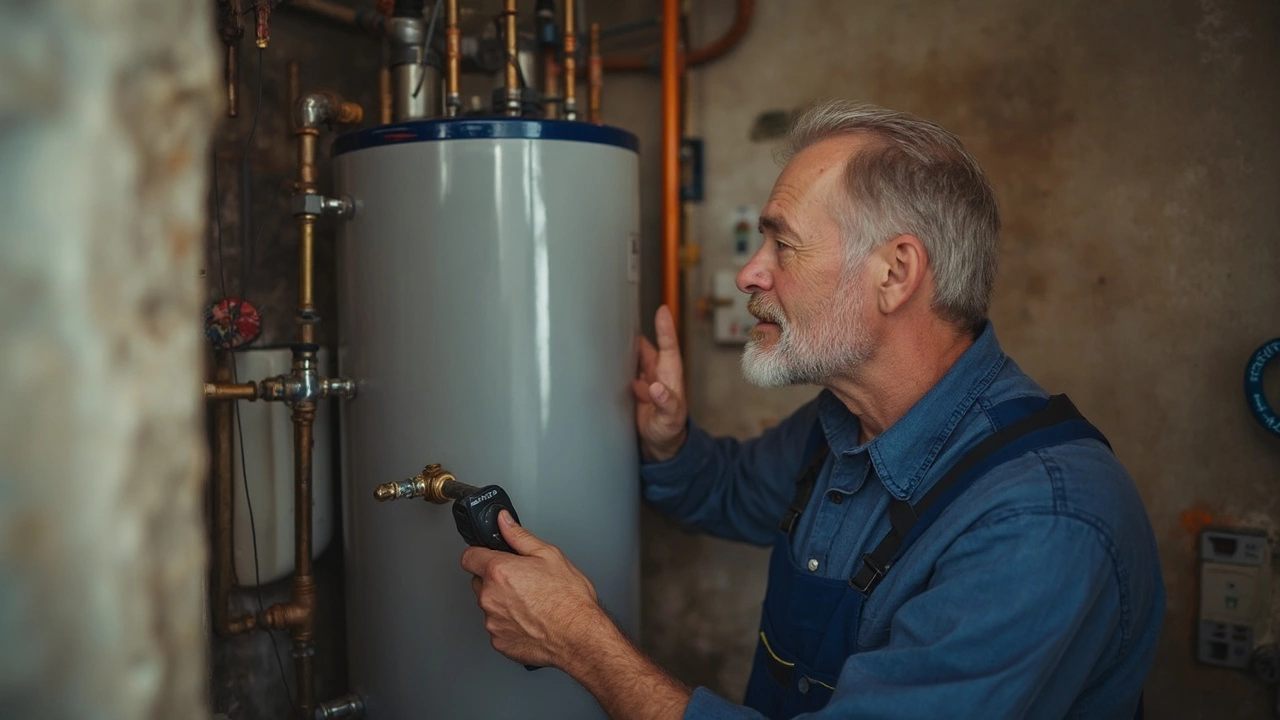Nothing kills your day like a water heater that decides to quit on you. Hot water on demand sounds pretty basic, but these machines fail in ways that can totally catch you off guard. Most issues actually come down to a few common parts that wear out or break.
The good news? Once you know what to watch out for, you can spot trouble before you’re stuck with an ice-cold shower. Most water heaters don’t just stop working out of nowhere—there are signs, if you know where to look, and some problems are a lot more common than others.
Let’s get into what usually fails first, why it happens, and how you can spot issues early. Saving yourself hassle (and possibly a bill from a repair guy) just takes a bit of basic know-how.
- The Heart of the Problem: Heating Elements
- Those Tricky Thermostats
- Loose Connections and Bad Wiring
- Pressure Relief Valve and Leaks
- Is It Time for a New Tank?
The Heart of the Problem: Heating Elements
If you’ve ever turned on the hot tap and still got cold water, chances are the heating element is the culprit. For both electric and hybrid models, this part is the true workhorse—it does the heavy lifting, actually heating the water inside your tank.
Electric models almost always have either one or two heating elements. Over time, these can burn out, get covered in mineral build-up, or simply fail due to normal wear and tear. If your water stays cold or heats up way too slowly, you’re probably dealing with a shot heating element.
Here’s a quick breakdown of why these parts flame out:
- Hard water minerals (like calcium) build up on the elements, making them less efficient.
- Elements work non-stop—they just wear out after a few years, usually 6-10, depending on your local water quality.
- Dry-firing: This happens when the heater runs while the tank is empty—an element can burn up in under a minute if exposed to air.
Spotting a failed heating element isn’t hard but can easily get missed. The hints are there—cool showers, slow recovery times, or half-warm water. If you’re handy, you can test the element with a multimeter. Replacing an element isn’t rocket science, but always kill the power first. Safety matters.
Here’s a snapshot of just how often heating elements go south compared to other parts:
| Common Water Heater Failures | Usual Lifespan | % of Calls (National Average) |
|---|---|---|
| Heating Element | 6-10 years | 31% |
| Thermostat | 6-10 years | 16% |
| Tank Leak | 8-12 years | 26% |
| Pressure Relief Valve | 8-10 years | 12% |
Want to help your heating element live longer? Flush your tank every year to keep minerals at bay. If you have really hard water, consider a water softener—it can pay for itself just in repair savings. The element may be where things go wrong most often, but with a little attention, you can stretch its life and keep that hot water flowing.
Those Tricky Thermostats
Let’s not kid ourselves—thermostats are sneaky when it comes to water heater problems. Just because you’ve set your dial to “hot” doesn’t mean you’ll actually get what you asked for. Most electric heaters have two thermostats: one at the top, another at the bottom. Both control their own heating elements, taking turns to get your tank nice and warm. If one goes out, you’ll notice a drop in water temp or a shower that runs only lukewarm before turning cold.
The thing is, thermostats tend to fail quietly. You won’t usually see them leaking, making noise, or falling off the tank. Instead, you’ll get little hints—like water that’s suddenly cooler, much hotter than before, or temps that bounce up and down for no reason. Sometimes, the reset button pops out and refuses to click back in. When this happens, the *real* culprit is almost always the thermostat, not the actual heating element.
- If water is icy but the power is on, check the reset button. If it’s tripped, push it back in.
- If water changes temperature a lot, it’s likely your thermostats aren’t communicating well and need to be tested or swapped out.
- If you hear constant clicking or popping from the heater and can’t get steady hot water, that’s another red flag.
Here’s a quick tip for DIY-ers: Use a multimeter to test the thermostat’s continuity. Just make sure the power is OFF—getting shocked is not the kind of wake-up call you want. Most thermostats are affordable and swapping one out isn’t rocket science, but if you’re not sure, it’s better to call someone who does this for a living.
Ignoring thermostat issues will eventually take down the rest of your water heater repair strategy. The heating elements and wiring all depend on the thermostat giving the right signals. Fix these little gremlins early and keep your hot showers going strong.

Loose Connections and Bad Wiring
One headache that pops up a lot with water heater repair: wonky wiring and loose connections. If your heater keeps tripping the breaker or seems totally dead, electrical problems are often to blame—even if you’re not messing with an old system. It’s not weird to see wires come loose just from the heater’s regular vibration, or from heat cycling on and off day after day.
Bad wiring isn’t just annoying—it can be a real safety hazard. A loose wire can cause arcing, which means electricity jumps where it shouldn’t and could lead to melted parts or even a fire. If you’ve ever noticed a burning smell near your heater or you see scorch marks on the panel, turn that thing off and call someone who really knows what they’re doing.
Here’s what usually causes electrical issues in home water heaters:
- Poor factory connections or weak after-market repairs.
- Rust or corrosion making contact points unreliable.
- Pests (yeah, mice can chew through wires).
- Too much moisture inside the electrical panel.
- Tight bends or stress pulling wires loose over time.
If you’re comfortable around electricity (and know the basics of safety), you can do a quick check:
- Make sure power is completely OFF at the breaker.
- Take off the access panel and look for signs of burnt wires, loose screws, or melted insulation.
- Tighten up any loose terminals with a screwdriver—just be gentle, you don’t want to strip anything.
- If you spot corrosion, carefully clean it off with a small brush and a bit of contact cleaner.
Some numbers for you: Recent home inspection data shows that over 10% of water heater failures in homes under 10 years old are linked to faulty wiring or loose connectors. That’s a lot of preventable cold showers.
| Issue | Percentage of Failures (%) |
|---|---|
| Heating Element Burnouts | 33 |
| Thermostat Malfunction | 22 |
| Loose Connections/Bad Wiring | 11 |
| Tank Leaks | 19 |
| Other | 15 |
If you’re not 100% sure about the wiring, leave it to a pro. Electricity is not the place to experiment. But regular checks and keeping an eye out for warning signs can help your water heater stay safe and running better for longer.
Pressure Relief Valve and Leaks
If there’s one part on your water heater you shouldn’t ignore, it’s the pressure relief valve. This little valve is a safety device. Its job is simple—release water if pressure inside the tank gets too high. Without it, the tank could actually explode. Sounds wild, but it’s happened before, and it always makes the news.
The pressure relief valve is usually on the side or top of your heater, with a short pipe running down. If you spot water trickling out now and then, that might be normal, especially after the tank heats up. But if you see a steady leak, or water pooling under the heater, that’s a warning sign. The valve could be faulty or there could be a problem inside the tank.
So why do these valves fail? Here are the main reasons:
- Mineral buildup: Hard water leaves deposits that make the valve stick or not seal well.
- Corrosion: Rust eats away at the metal parts, especially if the water heater isn’t flushed regularly.
- Old age: Valves are cheap, but they don’t last forever. Most plumbers say you should check or replace them every 3-5 years.
Checking the pressure relief valve is easy. Just lift the little lever on it for a second. You should hear (and see) a blast of hot water into the pipe. If nothing happens, or if the lever stays stuck, it’s time to swap it out.
Leaks can also show up in other places: fittings, temperature and pressure relief valve connections, or seam cracks in old tanks. A leaky tank is bad news. Unlike a water heater repair for other parts, a leaking tank usually means replacement, not repair. That’s because once the tank itself is corroded, there’s no real way to patch it up safely.
Tip: Catch small leaks early by looking for rusty water on the floor, or listening for hissing sounds near the tank. Acting fast can save you a soaked basement and a bigger bill later on.

Is It Time for a New Tank?
At some point, fixing bits and pieces of your water heater turns into just throwing money at a lost cause. The tank itself is what usually decides the real "end of life" for almost any water heater repair. That’s because the tank deals with constant pressure, heat, and—if you have hard water—a build-up of minerals that wrecks its inside over time.
If your water has started looking rusty or has a metallic taste, that’s a solid tip-off the tank might be corroding from the inside. Weird rumbling or popping noises aren't great news, either; that usually means sediment has hardened at the bottom and is causing extra stress. Leaks at the base of the heater? Unfortunately, you’re probably better off with a fresh start.
Here’s when you should really think about calling it quits and swapping in a new tank:
- Age: Most tanks last 8–12 years. If yours is creeping up on (or past) that, upgrades aren’t far away.
- Leaks: Consistent leaking from the tank itself means the inner lining probably failed—major red flag.
- Heating problems: If you’ve already swapped out parts like thermostats or elements and nothing’s working, the tank’s probably the issue.
- Visible rust: Rust on your water inlet or pressure relief valve can mean corrosion is spreading from within.
- Weird noises: Banging, gurgling, or popping sounds mean trouble in the tank’s lower section.
If you’re seeing two or more of these, stop pouring cash into repairs. Here’s a quote water heater techs throw around all the time:
“Once the tank goes, there’s no real fix—replacement is your only reliable option.”
Some numbers make the decision pretty clear too. Check out this breakdown:
| Tank Age (years) | % Failure Rate |
|---|---|
| 0-5 | 10% |
| 6-10 | 40% |
| 11-15 | 70% |
| 16+ | Almost 100% |
No one likes surprise expenses, but ignoring old or failing tanks just sets you up for flooding and bigger headaches. If your heater is ancient, leaking, or giving you other warning signs, replacing it is honestly the safer (and sometimes cheaper) bet in the long run.


